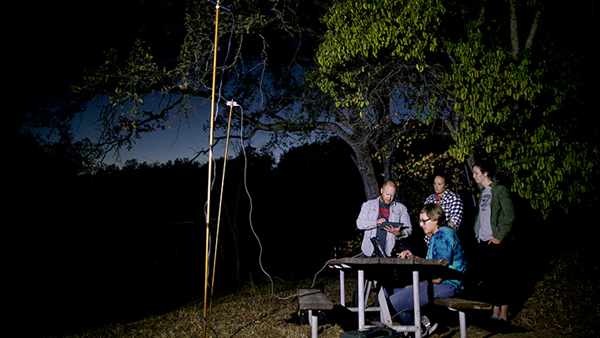Most people see bats as pests or fear them because some can carry rabies, but bats do more good than harm, said Fresno State biology professor Dr. Joshua Reece, who is part of a research project studying the behavior and sounds of bats.
Bats are important from a biodiversity standpoint. They provide a benefit to humans by eating crop pests and mosquitoes that might spread disease.
“Many bats consume their body weight or more in insects every night,” said Joshua, who is overseeing the species identification and sound recording.
There have been no reports of bats attacking people, he jokes, although they would bite if you somehow managed to grab one out of the air.
Don’t touch bats, he warns.
Joshua and his research team of undergraduate and graduate students in the College of Science and Mathematics are collaborating on the study with Fresno State neurobiology professor, Dr. David Lent. The team started working with biologists in Sequoia and Kings Canyon National Parks over the summer to identify different species of bats through their calls.
This fall, the group will do similar work on campus. A $10,000 grant for course-based research opportunities will allow the team to install about 30 bat boxes around Fresno State. Funding is from Associated Students, Inc., from a National Science Foundation grant, and from the College of Science and Mathematics and the Jordan College of Agricultural Sciences and Technology.
Biology major Robert Seward helped identify locations on campus for the bat boxes. Most Valley bats are tree roosters, not cave dwellers. Locations were picked based on what might resemble a bat’s natural habitat and access to water.
“Research has been so fun,” he said. “It’s crazy, because a year ago I never considered being a scientist as a real career.”
The Fresno Chaffee Zoo will also participate by installing boxes on its property. The goal: to get bats roosting in the box, to determine the species and to use soundscapes to find out why they like certain boxes, or locations, over others.
“We’re going to monitor the boxes with our students who are doing research in introductory biology classes and with some of the upper division classes,” Joshua said. “It’s experiential learning. It will allow students to develop their own hypotheses, test them and encourage their own critical thinking and love of science.”
In the parks, students use microphones to capture bat calls. Each species has a unique sound used to navigate by echolocation. The students record the calls and then determine the bat species based on the pattern of its echolocation.
The students also put out nets to catch bats (without harming them) so park biologists can take measurements and swab them for diseases like white-nose syndrome, a fungal disease killing bat populations across North America.
Long-term bat monitoring is necessary in case entire species or populations of bats start to disappear, Joshua said. “If you’re not up there watching, you wouldn’t know what is happening,” he said.
Graduate student Shelby Moshier loves the hands-on research she has done in the Reece Lab the past two years.
“You don’t get an experience like that in a classroom,” Shelby said. “It’s really cool. It’s crazy, a couple of species of bats you can hear because they call at lower frequencies like tick, tick, tick, but there are a lot of species that call at a frequency like a dog whistle.”
See more.
Hear bat call.
|



